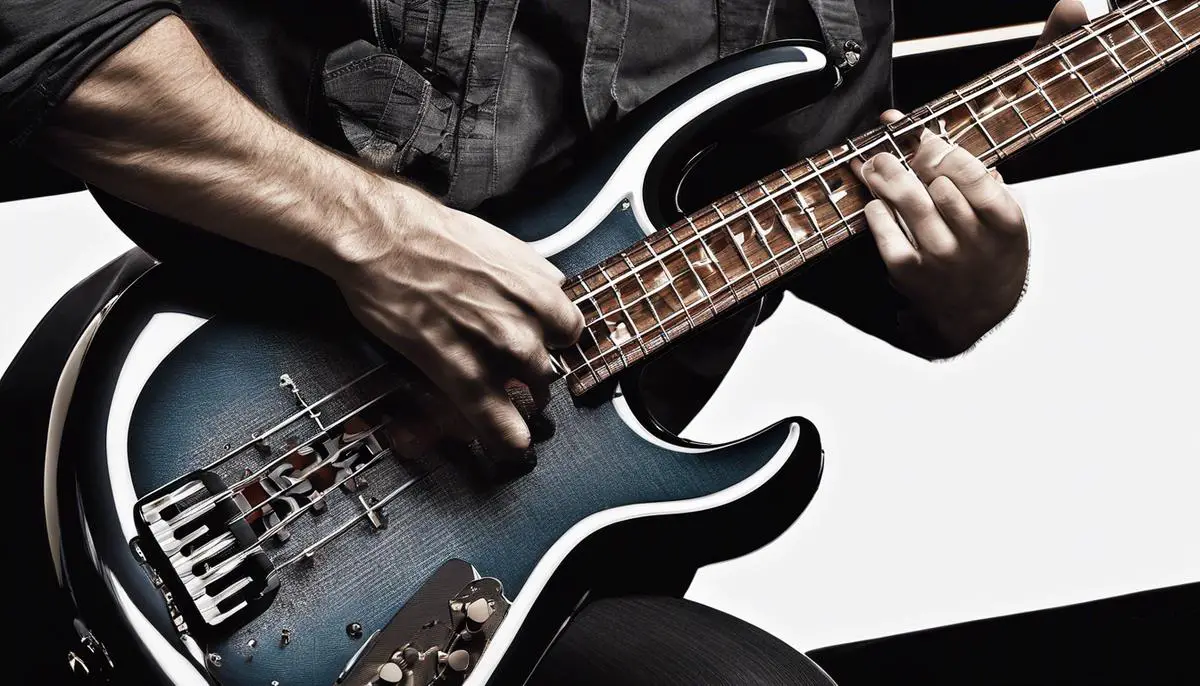Stepping into the world of music, especially one that revolves around a PBass, is both an enriching and experiential journey. Yet, a bump along the road that many often encounter is dealing with fret buzz – an inconsistent and displeasing sound that can stem from various factors like fret spacing, neck relief, and string action.
This phenomenon can deter your playing skills and undermine your performance. Empowering yourself with the knowledge to understand the root causes of fret buzz, inspect your Bass, and overcome this hurdle will significantly enhance your musical abilities and the overall quality of your instrument’s sound.
Understanding Fret Buzz
The All-Encompassing Rumble: Decoding the Enigma of Fret Buzz on Your PBass
An unexpected guest saunters into every string player’s journey – The Fret Buzz. This uninvited interrupter of harmony often manifests in your beloved Precision Bass (PBass), leaving you mystified and slightly on edge. Breathe easy, for fret buzz is simply a note’s complaint of being stifled and, when understood, can be silenced. After we sail through this mystery, your PBass will sing undisturbed melodies again.
First, let’s dive into the heart of fret buzz – the strings. This buzz commonly occurs when a string collaterally vibrates against an unintended fret. Why does this collision happen, and where does the fault lie? The trilogy of string height, fret condition, and neck relief often holds the answer.
You may think pressing a string down completes its journey, but it’s only the beginning. When plucked, a string oscillates in a grand elliptical dance. If the dance arena – the string height, or ‘action’ – is too confined, it will brawl with the encroaching frets, causing a buzz. To avoid such confrontation, action needs to be set to the perfect degree, allowing the string liberty to vibrate while maintaining player comfort.
Every orchestra requires an unmarred stage, and the PBass is no different. Enter the realm of fret condition. Worn-out, uneven frets are invitations for buzz. Even a single unlevel fret has the power to create unwanted noise. Therefore, keeping an eagle eye on the state of your frets and having them professionally dressed when needed is essential.
Our last pit stop is neck relief – the provocative curvature in the neck of the PBass. Is your neck perfectly straight? You might want to reconsider. A PBass neck requires an iota of concavity, a gentle bow that gives the strings their much-needed breathing room for unhindered performance. Without this relief, the oscillation could result in low and mid-neck fret collision, resulting in – you guessed it – buzzing.
Just as the complexities of music never fail to captivate and enthrall, the intricate balance that the hardware of your PBass demands is equally crucial. One important caveat is that these elements engage in a delicate interplay where adjusting one aspect might affect the rest. The solution may lie in compromise, perfect balance, adjusting, and readjusting until you hit the jackpot – a PBass resonating deep, ground-shaking notes, utterly devoid of fret buzz.
As you navigate this journey, remember that music is not just an auditory experience but a tactile one involving numerous minutiae, which, when realized, paves the way for your beautiful musical journey. Let these hindrances be your guiding light towards the ever-elusive perfection of sound. Now, scrutinize your cherished PBass and let it resonate with the music universe, untouched by the annoyance of fret buzz.

Inspecting Your Bass
In the realm of harmonies caught in time and strings that echo the depths of creative souls exists a pet peeve that can bring the most inspired piece to a screeching halt – fret buzz. Much akin to an artist constantly sharpening their tools for better expression, a musician’s duty remains to ensure instruments play their part without a fuss. Hence, the PBass, a beautiful canvas of auditory artistry, warrants consistent inspection. Let’s decipher the steps to uncover and deal with fret buzz.
Immerse yourself in the calming quiet and begin with the strings. Hold each string down at the first and last fret – the ears must become detectives, fully attentive to the whispers of dissonance. Play each note slowly, listening for the unmistakable rattle of fret buzz. Ideally, the strings should caress the frets gently. Any vigorous contact is a plea for attention.
Once the unrest is identified, delve deeper to inspect the truss rod, the silent spine supporting the unruly strings. Use a capo on the first fret, a finger on the last fret, then inspect the 8th fret. If the string rests too close, tighten the truss rod to induce concavity; if there’s substantial space, loosen it instead to reduce the neck’s curvature. Following the subtle whispers of the components can lead to harmony.
Music, essentially a symphony of detail, compels care towards the action, the distance between strings and the fingerboard. For the PBass, a low action typically curtails buzz but can affect the tonality; hence, a medium action of around 3/32” usually results in sonic bliss. Much like the intricate dance of notes on a music sheet, adjustment of action calls for fine-tuning to hit the right note, quite literally.
Furthermore, the breath of life for harmonious strings, the nut, should be scrutinized. Situate a feeler gauge of 0.2mm between the first fret and string, which should graze each other. If the clearance is substantial, the nut might need a lift or a shimming; if it’s less, then a file down.
Next, carry out a fret rocking test. Rock a straightedge along the length of the neck over three frets at a time. Should it wobble, the frets might be uneven, prompting fret leveling or a dress-up for the sharper ones.
Finally, confirm the pickup height. Lowering the pickup stops it from pulling on the strings, which might be causing the buzz. The balance between magnetic pull and undisturbed string vibration needs to be struck; a higher or lower stance might lead to sonic disarray.
In the heart of every PBass lies rhythmic perfection, only hindered by something as trite yet disruptive as fret buzz. As music curators, we must put the bass in its best shape, which resonates with our musical aspirations. Let’s cherish the orchestral journey a PBass unravels. So keep those tools handy, those ears sharp, and let the PBass reverberate without a buzz, like music flowing in its most actual form.

Fixing Fret Buzz
Unraveling the fret buzz conundrum on your Precision Bass isn’t merely a session of technical tinkering — it’s a heartfelt, rhythmic pursuit of perfect tonality and smooth playability. The sequence of steps to root out this unwelcome visitor in your harmonious journey is multi-faceted, just like the diversified genres of music you treasure.
The truss rod, that seemingly innocuous metal bar, is crucial to your sensory, stringed symphony. Checking it for proper curvature is as careful and attentive as fine-tuning a composition. Understand that the rod needs to be adjusted, forming a gentle arc that screams a more sweet ballad and less punk rock rebellion. In this musical maintenance, a truss rod wrench will be your conductor’s baton, ushering in harmony between the neck and the strings.
Just as a musician evolves, so must the action of your PBass. Adjusting the action refers to tailoring the string height to your touch and tonality preferences, favoring comfort and an optimal soundstage. Take caution while sinking into this remediation stage – the strings shouldn’t twang a metal symphony against the frets, nor should they float too high, singing a discordant air ballad. Set the string height to your preferred level using the saddle height adjustment screws. The strings should croon a melody that feels and sounds just right.
The nut of your PBass, much like the unsung composer of a famous piece, dictates the order of the day. Scrutinize the nut slots for appropriate clearance. They shouldn’t be too low, causing fret buzz, or too high, making the strings harder to press down. These tiny crevices hold the key to a bass ballad without interruptions.
Performing a fret rocking test to identify uneven frets is akin to practicing scales – essential and illuminating. Equipped with a fret rocker, gently test each fret for unwelcome movement. Any see-saw motion is a rogue note in your otherwise harmonious string concerto, indicating unlevel frets that may play host to the fret buzz you aim to banish.
Confirming the pickup height for optimal sound balance is the final crescendo in your symphony of PBass maintenance. Pickups too close to the strings can be overpowered, emitting an unpleasant distortion, while those too far away can create an echo of what your PBass is truly capable of. Make a point of adjusting these music-makers to a harmonious distance from the strings.
Remember, maintaining your PBass in top shape is like honing your skills and expanding your repertoire for those pulsating live gigs and intimate jam sessions. It’s an act that silently amplifies your aspiration and dedication to music. With these steps, the knights of rhythm and melody suit up to vanquish fret buzz, restoring your PBass to its rightful resonance and keeping that thumping bassline of your musical exploration rolling unfalteringly down the track.
Having delved into understanding the root cause of fret buzz, comprehended the inspection process for your Bass, and learned how to tackle these issues, you are equipped with the tools to diagnose and fix the problem and prevent it in the future. The journey to fuse your passion with knowledge is an ongoing process; every step is critical to refinement. The beautiful intersection between artistry and technical understanding only amplifies the delight of playing a PBass. Remember, a well-cared-for instrument blossoms into the music it creates, resonating the devotion put into its upkeep.


